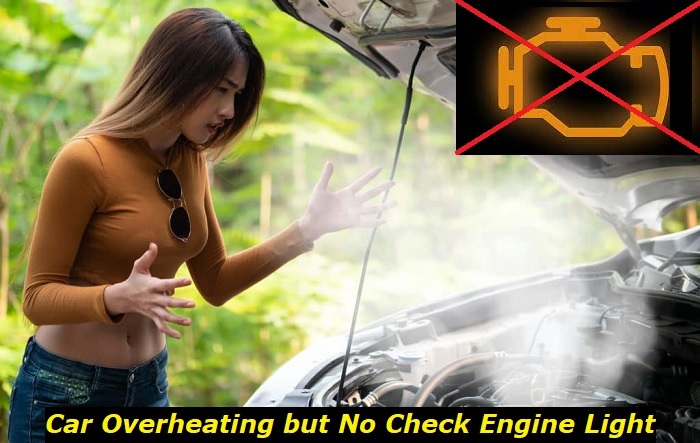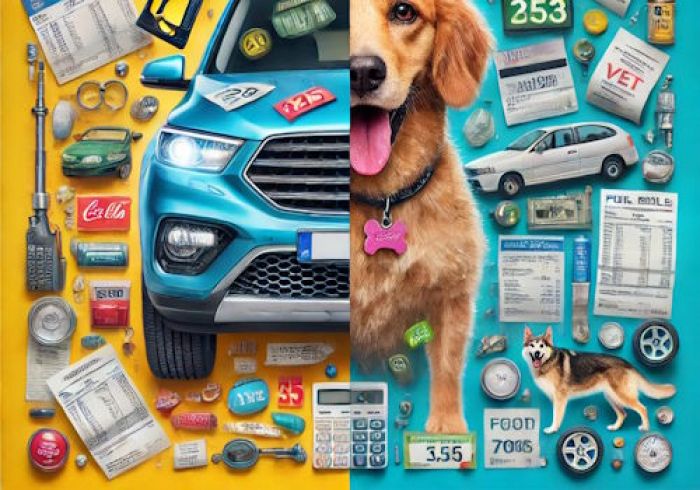An overheating engine is a serious problem and is usually the result of something going wrong in the engine. Normally the Engine Control Module (ECM) will catch the issue and turn on the check engine light to bring your attention to it. You should then be able to use an OBD2 scanner to look for codes and get an idea of what's causing your car to overheat.
Engine overheating highlights
- Level of urgency:very high
- Commonreasons:low coolant, thermostat problems, coolant blockage, radiator fan problem
- DIY diagnostics:possible but complicated
- DIY repair:impossible
- Price of repair:$300 - $650
- Time for repair:3 - 6 hours
- If ignored:engine failure, low performance, cooling equipment damage

Why isn't the Check Engine Light On?
The engine of your car is packed full of sensors that detect malfunctions and problems in the engine. When a sensor detects something wrong, The ECM will receive the error and turn on the check engine light.
Most of the issues that cause overheating in a car will also result in the check engine light coming on. When your car overheats without the check engine light coming on, it usually means that there is a problem with the check engine light or the ECM, or the overheating is caused by an issue the ECM hasn't deemed serious yet.
1) ECM Doesn't Register a Problem
When a sensor fails, the ECM will register a code and illuminate the check engine light. However, sensors don't typically fail suddenly. They gradually become less sensitive, or less accurate, until the ECM detects that the sensor is malfunctioning.
Certain engine components behave similarly. They might not stop working altogether but will slowly become less effective without the ECM taking note.
If a sensor or thermostat in the cooling system is on the verge of failure like this, then the cooling system may be no longer cooling the engine effectively, while the ECM has not registered the problem yet.
2) Faulty Check Engine Light LED
One of the most common reasons your check engine light might not come on is that there is a problem with the LED or its wiring. If something is wrong with your check engine light, then it won't turn on even if your head gasket blows.
It's very easy to ensure that your check engine light is still working. Whenever you start your car, all of your dashboard lights are illuminated briefly. You may have started your car so many times that you don't notice this anymore, but it's actually an important safety feature. This lets you check which warning lights are still operational, and which ones have failed.
If the check engine light isn't illuminated with the rest of the lights, then it is faulty and needs to be rewired or replaced.
3) Faulty ECM
If the ECM is damaged or shorted out, then the car won't be able to register or store any codes. As a result, it also won't be able to turn on the check engine light to warn you of any problems.
If you've already made certain that the check engine LED is still working, then you can diagnose a faulty ECM by removing any sensor harness and starting the engine. If the check engine light still doesn't come on, then there is a problem with the ECM.
Reasons Why Your Car Overheats
There are many reasons why your car might overheat, but they all stem from a problem somewhere in the cooling system. If you've managed to get your check engine light to show again, then you can scan for an OBD2 code that will help point you in the direction of the issue. If your check engine light is still off, then you can examine some of the common causes of overheating to find the cause.
Here are some of the reasons why your engine might overheat.
- Faulty Water Pump
A failing water pump is a common cause of overheating. The water pump is responsible for circulating the coolant through your car's engine. It pulls cold coolant into the engine to absorb heat and moves the hot coolant into the radiator to be cooled down.
Your water pump is one of the first places to check if your engine is overheating with no check engine light. This is because a faulty water pump will not cause a check engine light or a trouble code by itself.
If your water pump is corroded, leaking coolant, or whines when the engine is running, then it is failing and needs to be replaced.
- Faulty Thermostat
The thermostat is a critical part of the cooling system that controls the flow of coolant into the engine. It regulates the flow of coolant by opening when the engine is hot and closing when the engine is cold.
Sometimes the thermostat can get stuck in the open or closed position. When it gets stuck in the closed position, the coolant won't be able to flow into the engine, which results in overheating.
- Collapsed Coolant Hose or Worn Radiator Cap
The fluid in the cooling system needs pressure to operate. When the radiator cap is worn out, the coolant won't be able to pressurize effectively. This results in a poor flow of coolant through the system, causing ineffective cooling and overheating.
A collapsed radiator hose can also be caused by a faulty valve in the radiator cap or a vacuum in the cooling system. This is easy to spot, as the radiator hose will be flat rather than round.
- Low Coolant or Coolant Leak
Coolant plays a vital role in regulating your engine's temperature. If your coolant is too low, then the cooling system won't be able to dissipate excess heat through the radiator. This will quickly cause the engine to overheat.
If you've been adding coolant to your car to keep the temperature under control, but the coolant level keeps dropping, then you have a coolant leak in the cooling system.
How to Fix It
An overheating engine is a serious problem that needs to be addressed as soon as possible. If overheating is allowed to continue unchecked, it can cause serious damage to the engine. If the check engine light won't go on, and there are no codes to scan, then it's difficult to know where to start looking.
Let's take a look at how to fix some of the more common causes of your car overheating.
1) Change Water Pump
A faulty water pump will need to be removed and inspected. If the pump is faulty or damaged, then it will need to be replaced with a new one.
If the pump is clogged, you might be able to get away with cleaning it. There is a chance that the clog might have put some strain on the motor. This could have caused the motor to start burning out, so it is better to simply replace the pump.
2) Change the Thermostat
If the thermostat is damaged or stuck, it needs to be replaced. A bad thermostat can be repaired, but it is at risk of failing again. When it comes to your car's cooling system, it's better not to take any shortcuts.
You can locate the thermostat by following the hoses from the radiator into the engine block. The thermostat is located where the hose enters the engine. Once you remove the hose from it, you can remove the two bolts that hold it in place and replace it.
3) Change Radiator Cap
If the radiator hose is collapsed, you can usually fix it by replacing the radiator cap. If the hose springs back to its normal shape, then the problem is caused by an inoperative radiator cap valve.
If the cap is dirty or covered in residue, you can scrub it clean with detergent and a toothbrush. Radiator caps are very cheap, so we recommend that you get a new one instead.
If the rubber seal on the radiator cap is damaged, then the radiator cap will need to be replaced.
4) Fix Coolant Leaks and Top Up Coolant
If you notice that your coolant levels keep dropping rapidly, you might have a coolant leak. Before topping up your coolant, you will need to find the leak and seal it.
To find the leak, look for traces of green coolant fluid at these parts of the engine.
- Dented or cracked radiator
- Cracked radiator hoses
- Slacking hose clamps
Once you've found the cause of the leak, you will need to replace the damaged part. After that, you can top up your coolant.
Conclusion
If your car is overheating and the check engine light isn't on, you might have a tough time diagnosing the cause of the problem. In some cases, the check engine light might be off because it's gone bad, or the ECM is malfunctioning. In other cases, the ECM might fail to notice that a sensor or component is going bad.
Whether you can finally scan trouble codes or not, overheating is a result of a problem in the cooling system. Checking for leaks, and examining the pump, coolant and thermostat are usually enough to reveal the source of the problem.
About the authors
The CarAraC research team is composed of seasoned auto mechanics and automotive industry professionals, including individuals with advanced degrees and certifications in their field. Our team members boast prestigious credentials, reflecting their extensive knowledge and skills. These qualifications include: IMI: Institute of the Motor Industry, ASE-Certified Master Automobile Technicians; Coventry University, Graduate of MA in Automotive Journalism; Politecnico di Torino, Italy, MS Automotive Engineering; Ss. Cyril and Methodius University in Skopje, Mechanical University in Skopje; TOC Automotive College; DHA Suffa University, Department of Mechanical Engineering






Add comment